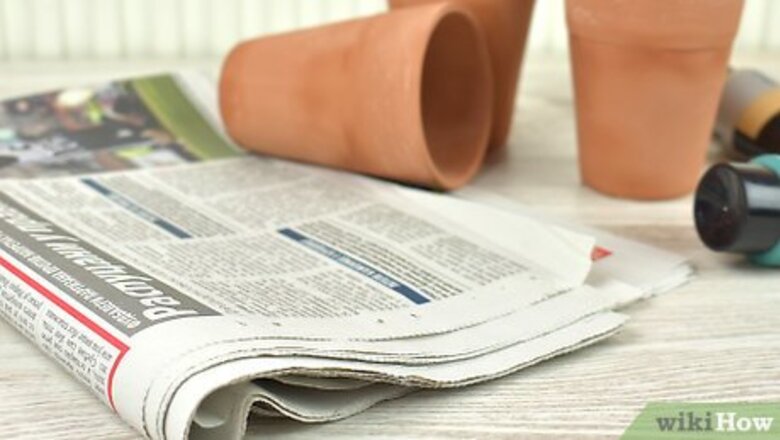
views
Prepping the Pot

Lay newspapers down on your workstation. Even the most careful crafters have spills, so make sure to protect the table or floor you are working on. You’ll be working with acrylic paint, which is water-based and pretty easy to clean if you do spill.Who wants to clean though? On that note, you should probably change into some work clothes too. It is preferable to set up your painting station somewhere out of the way, because it takes several days to fully complete a pot. The primers, paints, and sealers all need hours to dry, so set up your supplies somewhere you can leave them for at least 48 hours.

Soak the pot in warm water for about half an hour. This will help you peel off any price tags, as well as clean off any marks.Because these pots are often sold at home and garden stores, they might be slightly scuffed or dirty. It’s important to give yourself a clean terracotta canvas before you start your painting.
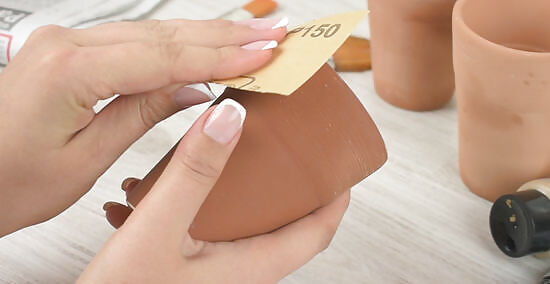
Dry and sand your pot. You can easily dry it by setting it in the sun for a couple hours. After it’s completely dry, take a piece of sand paper and lightly rub any rough areas or markings on the pot. The sandpaper can also remove any residue left behind by a price tag or sticker. If your pot is already clean and smooth after its bath, feel free to skip this step! Surface impurities on your pot will show through the paint, so make sure it’s as clean and smooth as you can possibly get it. The color of the terracotta will help you tell if it is dry. The pot will be significantly darker when wet, and lighten up as it dries.
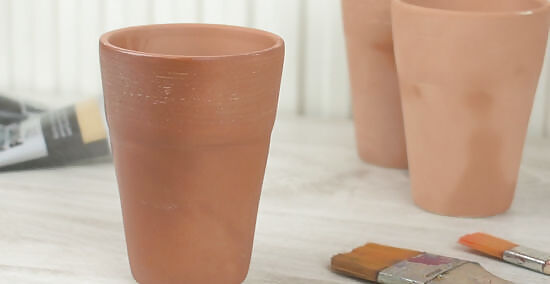
Apply a surface primer to your pot. Terracotta is a porous surface, so priming the pot is an important step. The primer will prevent the paint from bubbling or looking speckled, and it will give your pot an overall smooth and polished appearance. There are various kinds of primers with different instructions, so follow the instructions on the packaging. Cover all areas of the pot that you are going to be painting. Spray the areas you aren't going to be painting (such as the inside of the pot and the bottom) with the waterproof sealant. Make sure the primer and sealant are completely dry before you begin painting. Most primers are a plain white color, but feel free to tint them with your background paint color if you prefer. Tinting them with a darker color may be useful if you want your finished pot to be dark.
Painting your Pot
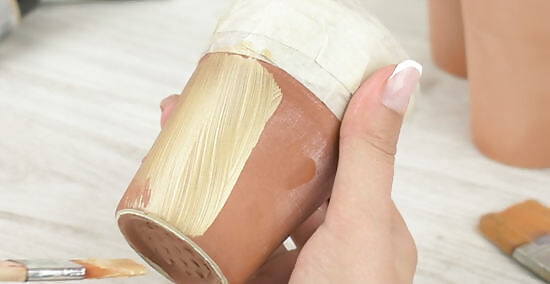
Apply your background color (or colors) first. If you want to use multiple colors for your background, it’s helpful to tape off the sections before starting. Place tape where you want a color of paint to end. You can then paint the color and peel off the tape, leaving a perfectly clean line. Allow your background to dry, preferably overnight. You may need to apply several coats of paint, particularly if you are using light colors. After your first coat of paint is completely dry, you can decide if you need one or two more. Always a coat to dry completely before adding another. By letting them dry in the sun, it’ll speed up the process and you’ll air out the paint smell!
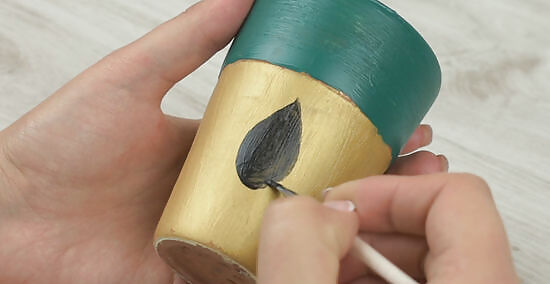
Paint on top of your background. Once your background coat of paint is completely dry, you can start painting on top. The possibilities are limitless. You can use stencils, create designs using tape, or even try your luck at free-handing something! Stamping the terracotta pot with stamps creates an interesting design. Just get creative! When you are all finished, allow the pot to dry completely. This step, of course, is optional. You can always leave your pot one solid color, depending on the look you are going for.
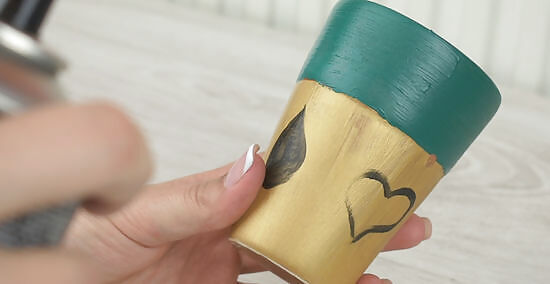
Seal your masterpiece. This is a crucial step, because the pots can peel, fade, and chip if you don’t seal the paint properly. Make sure you are somewhere with good ventilation, and spray the pot thoroughly with an acrylic sealer. It goes on clear, so it won’t mess up your painting. Spray until you think you’ve covered the entire surface of the pot, and then spray it again. You want to make sure you don’t miss an inch- even areas that you did not paint. The unpainted areas are still vulnerable to moisture, and if damage to unpainted areas can affect your beautiful painted areas! The sealant dries pretty quickly, but you should let your pot sit for a couple of days before you expose it to any moisture. This will ensure that everything is completely sealed and protected.
Getting More Creative
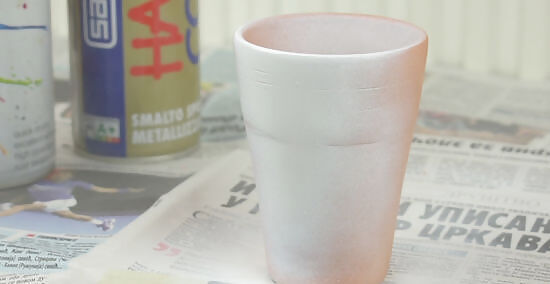
Take your pot to the next level by spray painting it. This will save you time, and it will also give your pot a really unique look. Play around with the distance between the pot and the spray paint, seeing the different spray patterns and intensities you can create. Use an acrylic spray paint, and make sure you do this in a well-ventilated area.
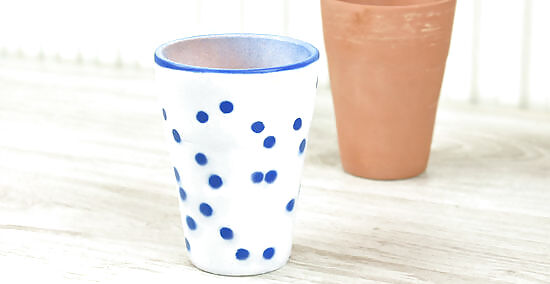
Make stencils to create intricate designs. It's best to use a material like poster board to create your stencils, so that it is thick while still being malleable enough to bend it against the surface of the pot. You can create a stencil of anything you want as long as you have the proper materials. Print off whatever image you want to use for your stencil. This can be an image, a letter, a design, etc. Tape the printed paper to the poster board, and use an X-Acto knife or other razor blade to cut it out. Stencils help you make exact duplicates of the same designs.

Use adhesive to add some 3D decoration to your pot. Using wood glue, you can add anything your heart desires. For a rustic look, you can add little twigs, pebbles, twine, fake leaves, and anything else you can think of. For a flashier look, try gems or other sparkly objects.
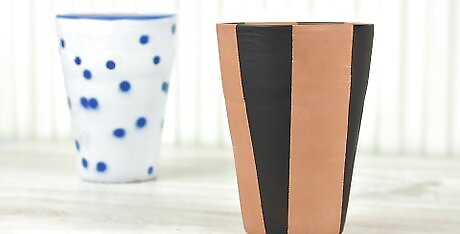
Leave sections unpainted for contrast. A fully painted pot looks great, but leaving portions of unpainted terracotta showing through can provide a neat contrast. It will be recognizable as an ordinary, every day terracotta planter, but with a little extra pizzazz. This looks great when the pot is positioned with unpainted terracotta pots, as it ties the arrangement together.

Try geometric designs, organic patterns, and even try combining the two. You can use duct tape to create bold, straight-edged designs, and you can also free hand with your paint to create gentle, flowing patterns. You can create a one-of-a-kind pot by using both kinds of designs on one pot!

















Comments
0 comment